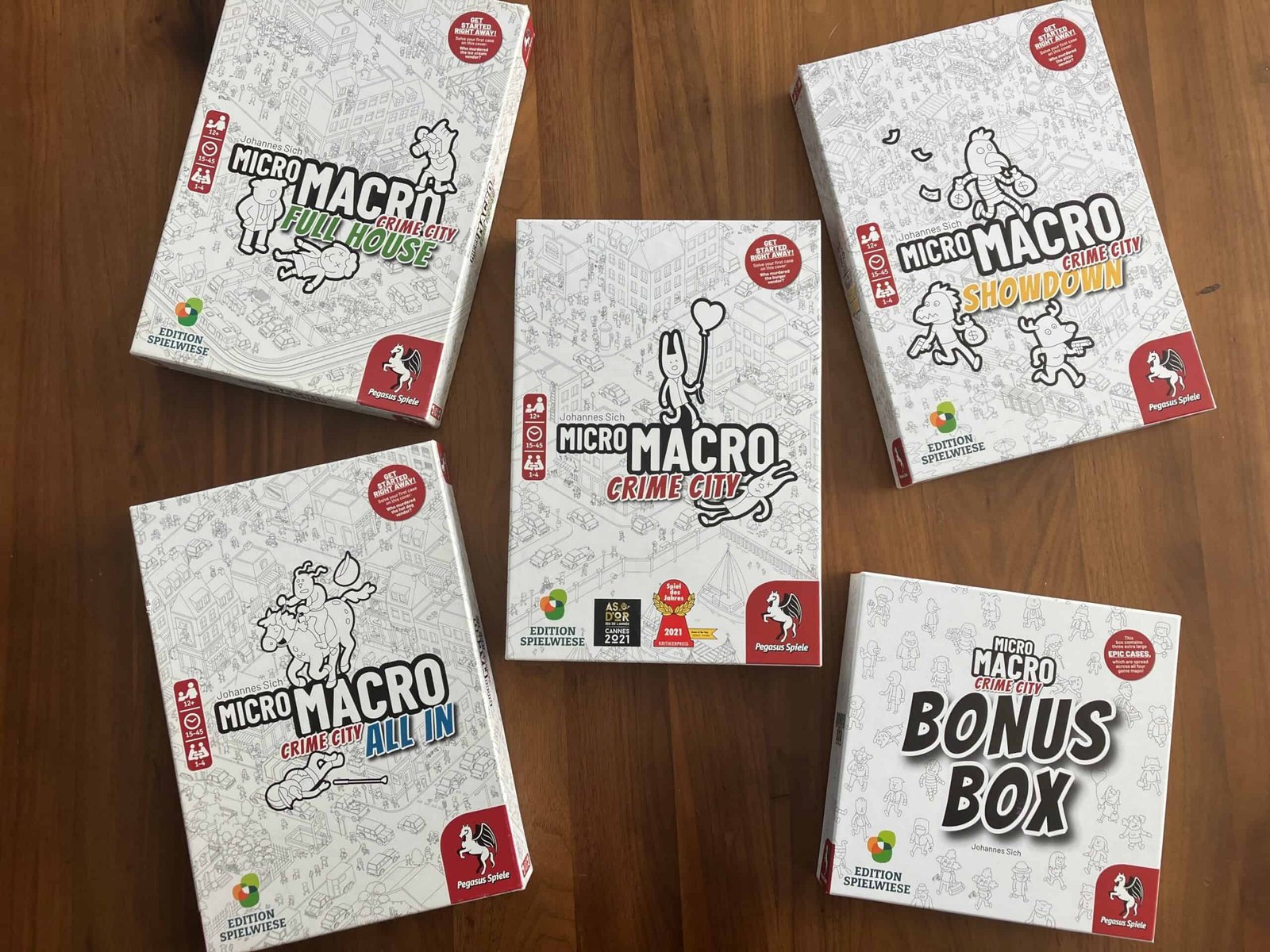
MicroMacro Crime City is the first in a series of story telling games that have players acting as detectives, using their investigative skills and deductive talent to help the local police, piece together the clues to solve crime by finding characters and events on a giant, table-sized map.
You are working together as a team of clever investigators helping local police look for clues. You all hunch over this paper map with funny cartoon characters getting up to all kinds of mischief across this City that rightfully earns its name as Crime City. Because you look around and the images on the map can be a bit morbid – cold blooded murders, devious robberies, and signs of violence everywhere – but the artwork style is whimsical and cartoonish.
Does that combination work and who is it for? Is this a game or an activity? We’ll answer all that and whether you should pick this up in our review below.
What is MicroMacro: Crime City?
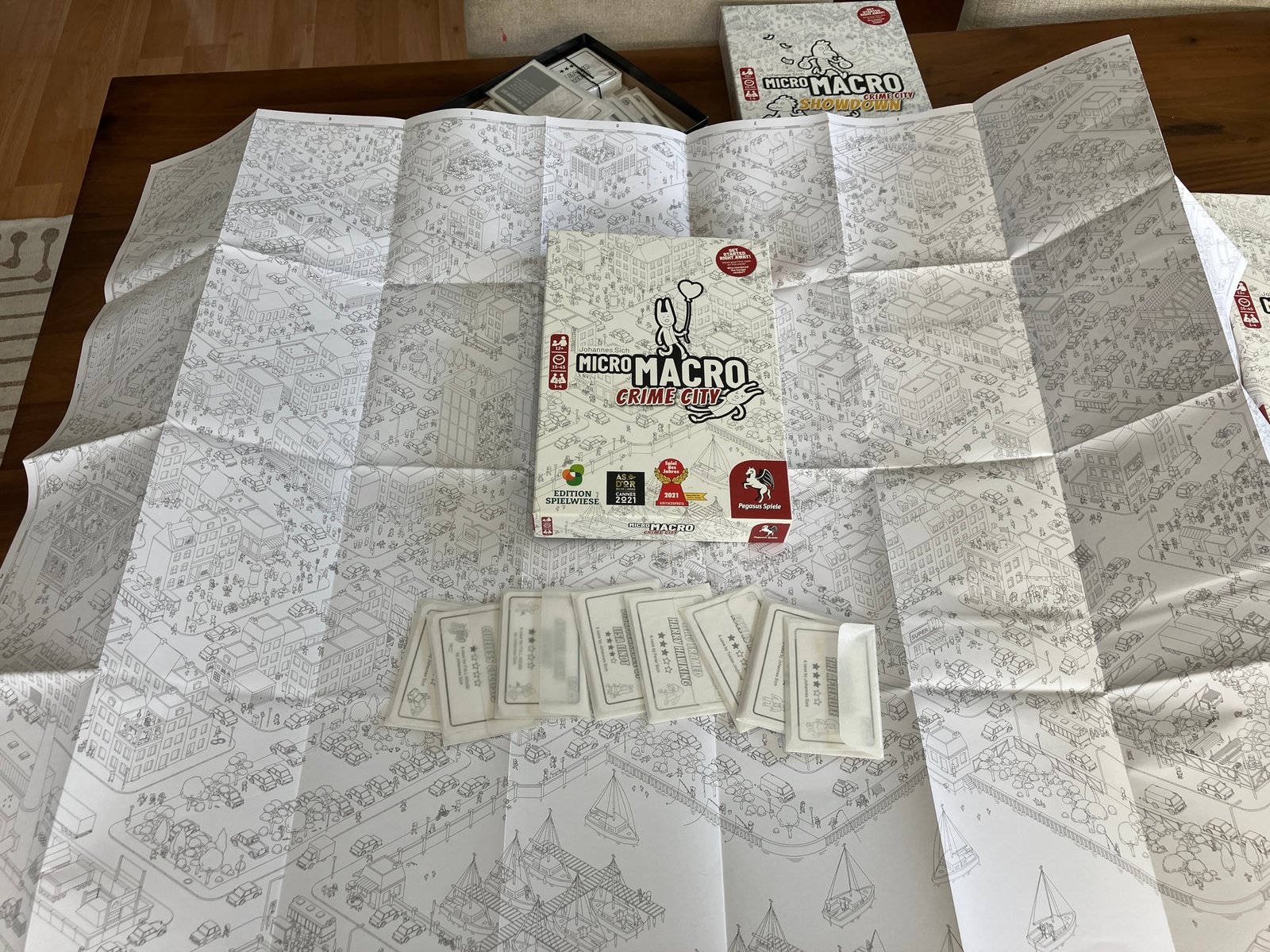
MicroMacro Crime City is a cooperative detective game, that comes with a big map of a city where crime lurks around every corner, featuring cartoon characters getting up to all kinds of mischief, mayhem, and, not infrequently, murder.
It was designed by Johannes Sich and published by Pegassus Spiele in 2020 to much acclaim receiving overwhelmingly positive reviews and ultimately winning the prestigious Spiel de Jahres in 2021.
The game comes with a map and a stack of cases that has detectives investigating crimes by looking for people and events across the map. Often players will work backwards from the scene of the crime tracing the events from earlier in the day to unmasking criminals or determining motives, revealing a story in the process.
But how is that possible? Well, the map is not a snap shot of one single point in time. So, for instance, if you are trying to determine what a criminal did earlier in the day, you can trace you finger up the sidewalk and, hopefully, find them walking toward the scene of the crime, keep going and you’ll be able to track their progress through the city – sometimes you’ll see them visit shops, remove disguises, or meet with accomplices or benefactors.
As you trace their progress through time, either before or after the crime, you’ll fill in the gaps in the story and ensure that the right people are held responsible. So, sure, you are searching for little people on a map like in Where’s Waldo? (or Where’s Wally?), but most of the magic here, comes from the stories and how they are slowly revealed through tiny discoveries.
What’s in the box?
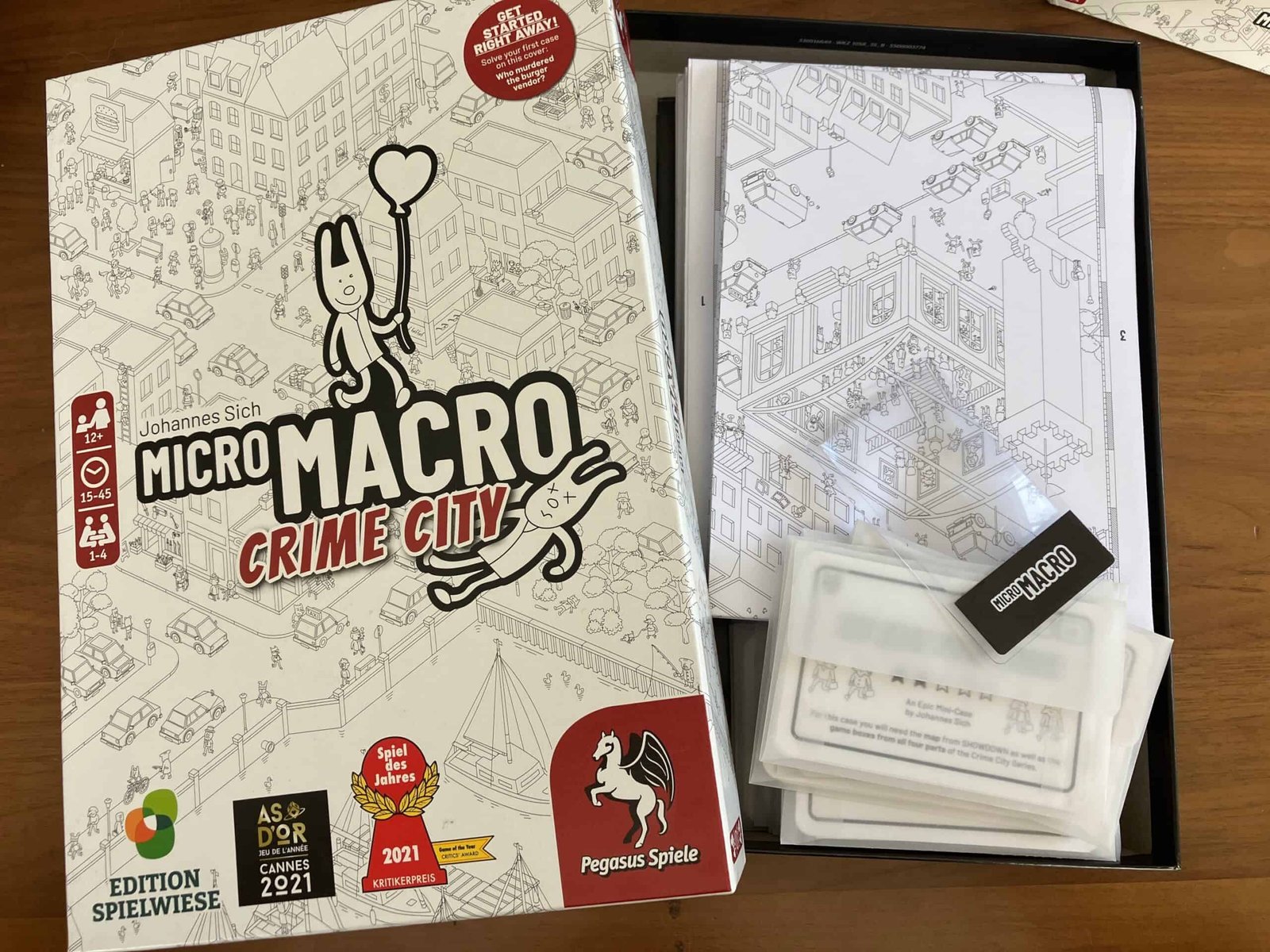
The game includes a poster sized (75 x 110 cm) map, a magnifying glass, and 16 sets of case cards, and semi-transparent envelopes to store each case. There are more cases available in the Bonus Box and there are multiple expansions when you need more cases to complete. More info on that below.
All of the components are good quality and will hold up to repeated use. It can be a challenge to get the map folded up in a way that folds back nicely in the box, but that’s mostly because it’s made of hefty quality paper.
The magnifying glass is useful, but if it’s consistently essential for any of the players, they’d probably do better with a more traditional magnifying glass. The included one was more than adequate for me and my play groups to zoom in on the details.
One thing that isn’t included but maybe should be is something to mark the various things you’ve already found on the map over the course of a scenario. I would recommend grabbing some small tokens or chips to drop onto the map to show where you’ve already found activity. Not necessary, but will help you keep track of where you’ve been.
How to Play
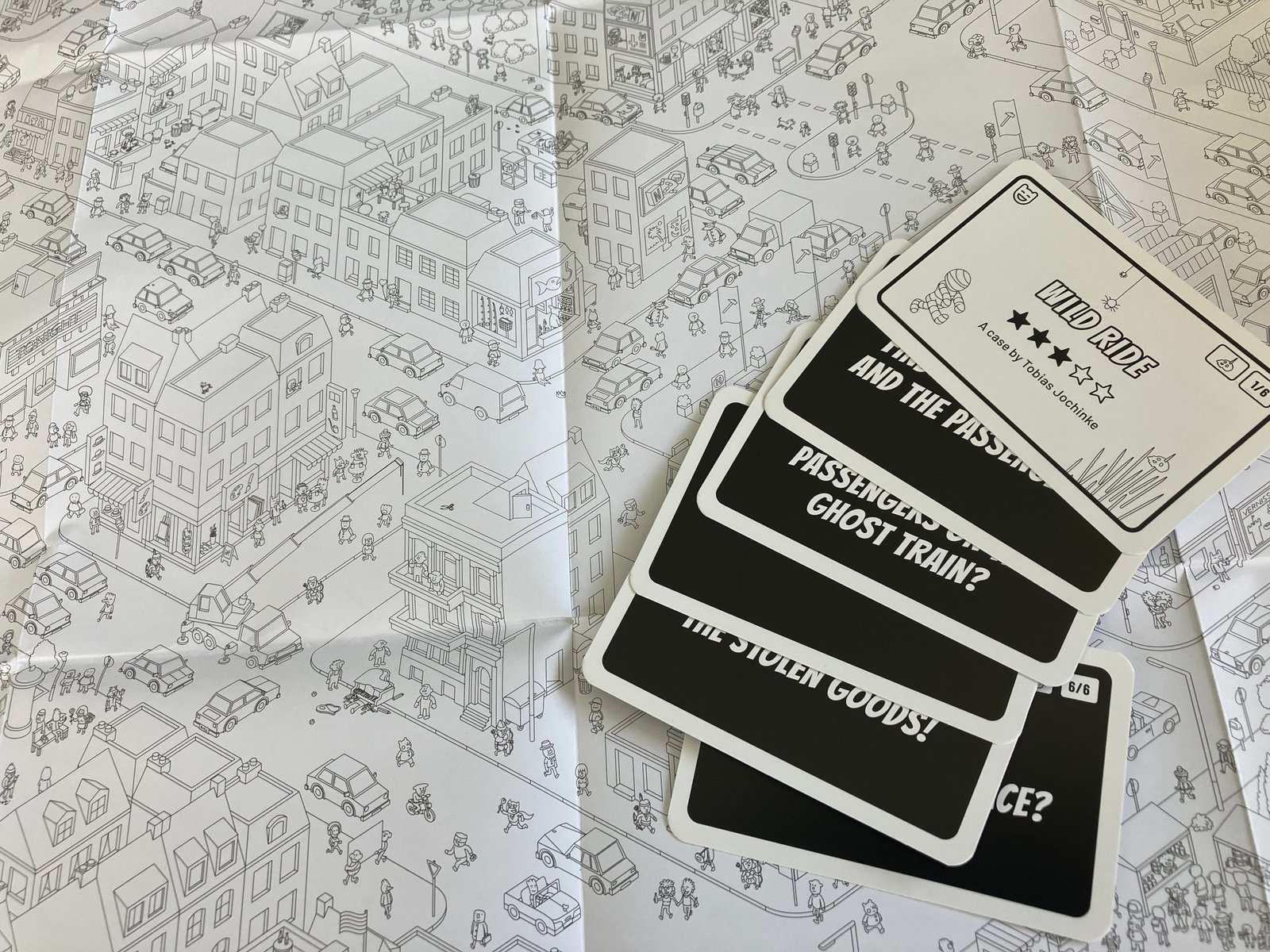
Begin by placing the map on the table so that everyone has access to it. It’s a big map so there will plenty of room around it. I’d say there isn’t an advantage to be facing it from one side or the other, so just make sure everyone is seated in front of a generous portion of map.
PRO TIP: if you can, try hanging the map on the wall. In my experience, this configuration probably works best with 2 players, but if you have any back problems or are opposed to hunching for some other reason, this can be a game changer. Plus it feels a bit like you are in the police station putting pins up on the map, trying to track the perpetrators next move. Try it, see if it works better for you.
Each case will start by reading the opening case card that will direct you to an area on the map, usually the scene of a crime. The next case card will ask a question that you’ll need to consult the map in order to answer. Like who did they meet with earlier, where did they hide the loot, or what was their motive. You’ll then trace the steps of the characters on the map through time, in order to answer these questions. Once you’ve answered all of the questions in that case stack, you’ve completed that case and can move on to the next.
Difficulty level
Each case pack is assigned a difficulty rating, beginning with a simple tutorial mission that teaches players the mechanics. Playing through that usually takes about five minutes and helps familiarize all players with the gameplay and get a taste for the process of finding evidence to figure out the details of a case.
I always want to play through all the cases and the difficulty level isn’t a huge factor for me in my enjoyment of the game. I just like sitting around the crime city map with friends or family and solving a murder – doesn’t really matter if it’s easy or hard. Because of that, in every box I’ve played through, I start with the easiest case and work my way through the stack, until I’ve completed them all.
That said, you might find you want to dial in the difficulty more precisely for your group. You also might have time constraints, which can be helped a lot by picking an easier case. So having that rating system is really handy. Even the way I play, I like tracking progress as I work my up to the more difficult, longer cases.
Age Range
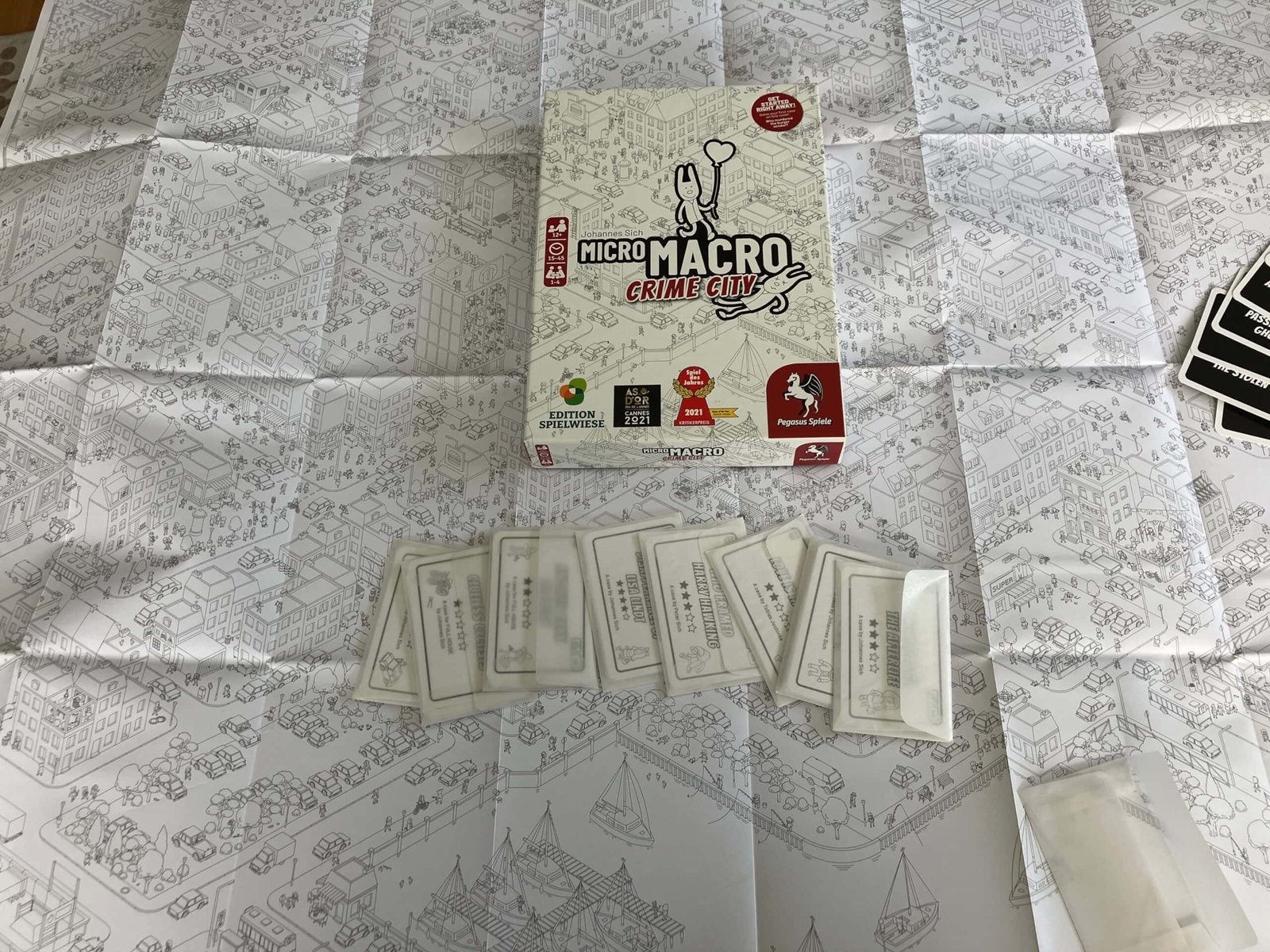
Determining what content to play with kids is the most confusing part of this game for me, because playing this with your older kids is a lot of fun. The game play is really appealing and satisfying to kids and the aesthetic is cartoon so they’ll likely be drawn to it, if you have it laid out on the table, but parents have to keep in mind that we are talking about cold blooded murders and you will be uncover criminal activity that you might not be comfortable with your child experiencing.
Fortunately, all the expansions, as well as the latest edition of MicroMacro Crime City feature a rating system for the intensity of the content – from kid friendly to not. This is very helpful to help control which ones you decide to solve together – without having to do research.
That was an issue in early reviews, but I’ve purchased this game twice, once before that rating system and once after (because I gave my first copy away after the person I played with liked it so much) and they’ve corrected that error in the latest printing. Problem solved.
Review: The Cooperative Detective Game Experience
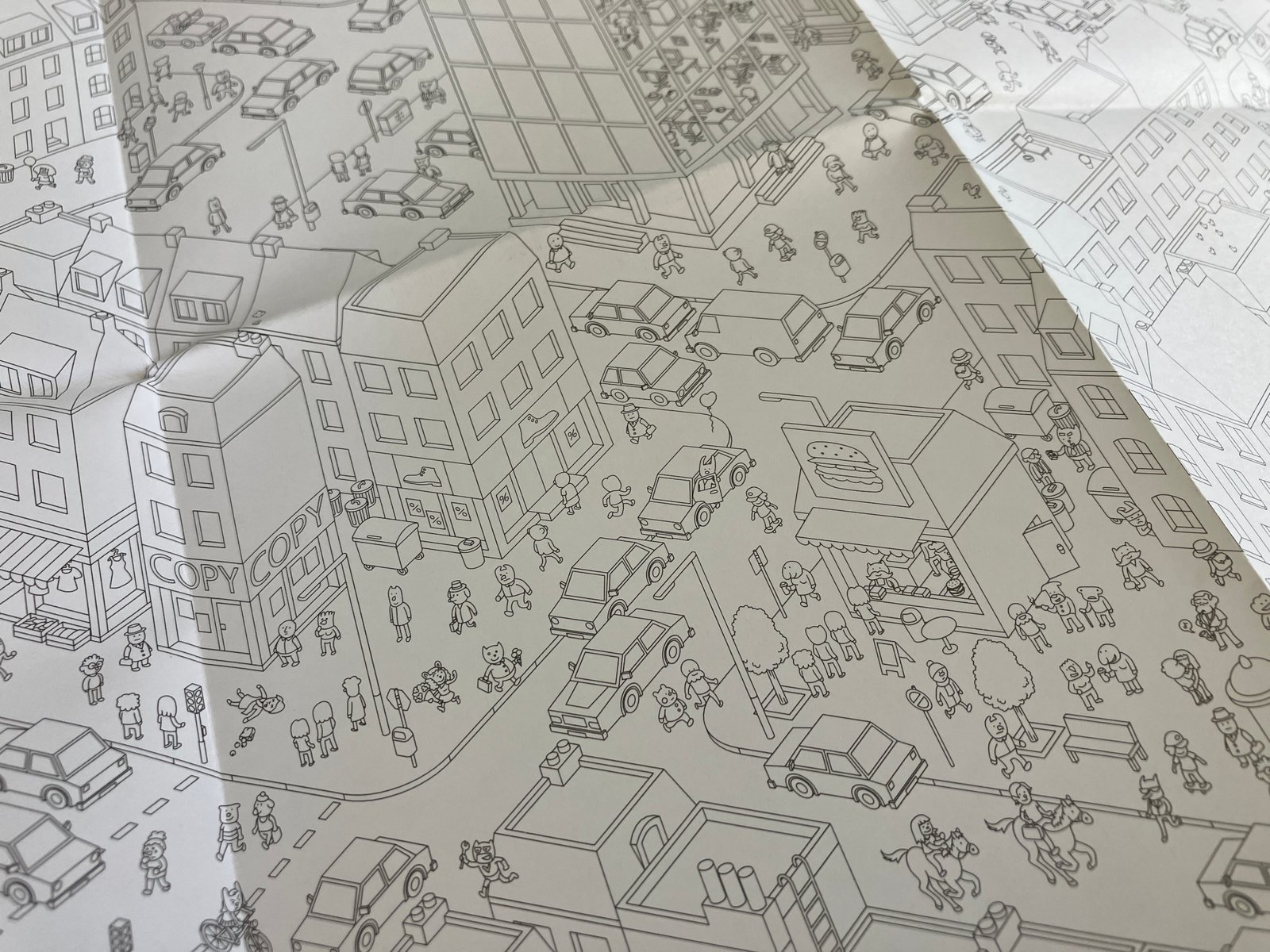
Solving Crimes Together
The Success of MicroMacro: Crime City is in its collaborative storytelling experience. If you were just looking for things on a map it would take a minute or two to solve and, of course, an all it would take is an attentive eye. But sitting down with a friend or two figure out what happened and search for criminal activity is so much more than that and the thing that sold me on this game.
The amount of detail that goes into the maps and the stories means that every case jumps off the page and into the player’s imagination over the course of the game. So you are telling stories together and when you are missing a detail that’s when the game is at its best. When you can’t just search the page to solve the mystery and you have to talk through what might have happened before you can locate the evidence.
Sometime that can take a minute, and sometimes you might get stuck, and sometimes you create false leads and end up down dead ends as you create a story that explains the motives of the perpetrators – but it isn’t quite right. It is much smaller in scope and much less difficult, but it manages to pack the appeal of the game, Sherlock Holmes: Consulting Detective in a much more accessible way. (I love that game, but you’ve got to have all the right circumstances in order to play it)
But it’s has that same felling where you build a narrative and it doesn’t quite fit, so you take that one apart, and build another one, perhaps more successful. This is a lot more straightforward than that game, but it’s the same type of pleasure of working together to right a progressively better story about what happened.
It’s a great experience, but…
Is it a Board Game?
There’s been a lot of talk in reviews about whether this is a game or an activity. It definitely has the feel of a puzzle, more than it has the feel of, say, Catan.
And, for what it’s worth, I agree that this is probably not a “game” per se and the reason I say that is because there is a right answer to each of the questions asked in the scenarios. There’s space, like I note above, for creativity and storytelling, and moments of cleverness and finesse, but other than having a keen eye, there aren’t many levers you can pull. You look for the answers until you find them and then the puzzle is complete. In a game, you participate in the drama a little more actively and the answers aren’t fixed. This game is literally “solved,” as we say of games that have been mathed out, but in this case it is because there are literal solutions.
But here’s the thing: that’s just theory and nonsense.
Is this fun? Does it draw people to the table and does it keep their interest while they are there? Yes. Absolutely.
So whether it’s a game or an activity, who cares. This is something you should sit down and do with your family and friends.
The MicroMacro Crime City Universe
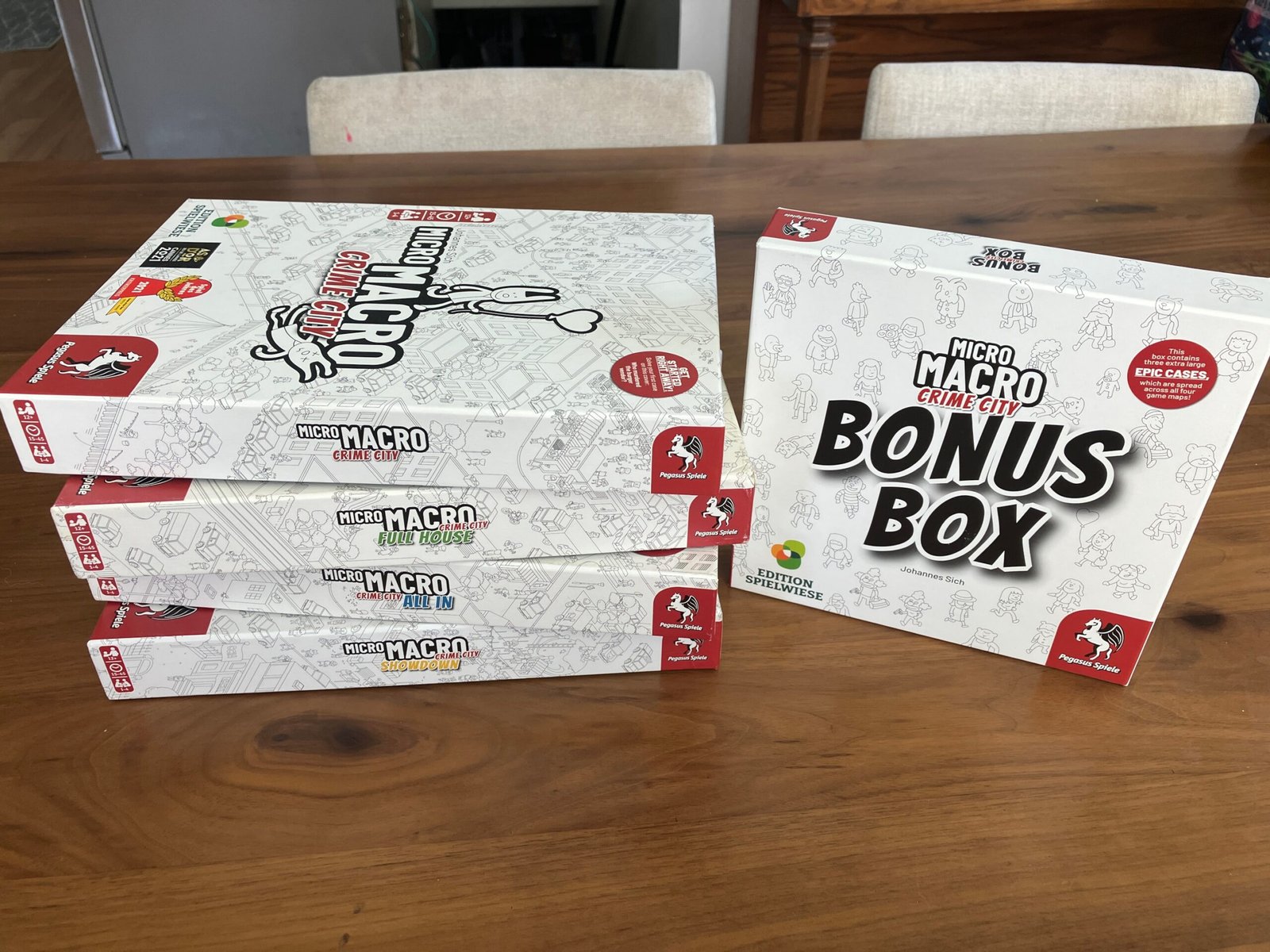
As of this writing there are now five MicroMacro Crime City games, each featuring a different portion of the city map and new cases to solve. Other than the Bonus Box, each is an independent board game and you can play any one of them, doesn’t matter which you get first. Once you have all four you have the full map of the city and there are even cases that send detectives across all four corners of the city map – found in the bonus box.
Buying in order worked out fine for me, but if you love the original, you might consider grabbing the bonus box early on so you can play the additional scenarios that it adds for each city map as you go. I would have preferred that, but since that didn’t exist while I was working my way through the game, I didn’t have that option.
MicroMacro: Crime City
The original game includes the Northwestern corner of the city and 16 cases to solve.
MicroMacro Crime City: Full House
Full House includes the Southwestern corner of the city map and 16 new cases to solve.
MicroMacro Crime City: All In
All In includes the Southeastern corner of the map and 16 new cases to solve. *probably my favorite cases
MicroMacro Crime City: Showdown
Showdown includes the Northeastern corner of the and 16 new cases to solve.
MicroMacro Crime City: Bonus Box
Includes 14 cases. 11 cases for Crime City, Full house, All In, and Showdown. It also includes 3 epic cases that span across multiple maps.
Additional content
Additional cases can be found online for Crime City, Full House, and All In at the publisher’s website here: https://micromacro-game.com/en/extracontent.html
Summary
Collaborative Storytelling: Encourages teamwork and creative narratives, making each session unique.
Detail-Rich Maps: Intricate maps and scenarios lead to immersive gameplay.
Accessibility: Suitable for a wide audience, including children, with a rating system for content intensity.
Easy to Learn: Simplified mechanics compared to traditional board games, making it easy for newcomers to join in.
Community Support: Additional content available online extends the game’s longevity.
Conclusion: Move Over Puzzles, Let’s Spread Out a Crime City Map
In MicroMacro Crime City crime lurks around every corner and you’ll get to explore it all. The stories jump off the page, and the game play is extremely simple for anyone to learn.
Next time you are tempted to pull out a puzzle for you or your guests – pull this out instead and work together to protect the city. Identify the criminal and save the day.
It’s a unique collaborative experience and one everyone should at least try. You might find you love it and, if so, there’s a whole universe to explore.
Looking for more? Read out article on the best Mystery Games here.
